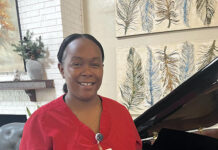
by James Coburn
Staff Writer
Kramer School of Nursing has invested time and talent in the quality improvement, said Staci Swim, faculty at Kramer School of Nursing at Oklahoma City University. The LEAN program at Kramer is an across-the-board process that Kramer adopted from INTEGRIS Baptist Medical Center as an improvement model.
Lean health care methodology is a strategy for better clinical outcome within an organization. It makes healthier, more efficient and high performing organizations, Swim said.
Dr. Carol Mannahan and Kramer faculty member Swim were invited to go for two days of training at INTEGRIS Baptist Medical Center to become LEAN certified leaders, Swim said. The LEAN program endeavors to find all of the waste in a process such as down time, over handling and confusion.
Kramer School of Nursing LEAN team members include Gina Crawford, DNP, MS, APRN-CNP; Lauren Riney, BS.; Sara Manning, MSN, RN, CNE; and Staci Swim, MSN, RN, CNE
“Anything like that to get it down to the bare minimum to help that process go smoothly,” she explained. “The maiden voyage was to find the low-hanging fruit in our environment that really needs some help. So what we had identified as a team is that our students in the clinical preparation of vaccination, CPR and other paper work that need to be done is our low-hanging fruit that we chose.”
INTEGRIS Baptist Medical Center provided a representative to Kramer to help start the program. Faculty examined the entire process from admission to the first day that students began their clinical work and identified areas that needed improvement, Swim said.
Each step of the process is drawn on a map by a collaborative team that included Student Health, she said. Three areas were noted on the step-by-step map.
Lauren Riney, administrative assistant to the dean, said the program is extremely beneficial.
“I have stepped in to help with the clinical requirements because of the absence of someone in that position,” she said. “It’s hard. There were a lot of gaps in the process and we’re trying to fix it.”
One of the gaps identified the need for a set deadline for immunizations, she said. And, not all of the students have recognized the importance of the immunization deadline, Riney said.
“It’s a big deal. It’s communications,” she explained.
Swim said the problems they identified apply to all schools of nursing as a common theme.
“Eventually, we’ve talked about taking it to NESA,” Swim said. “That’s where all the schools and hospitals come together to try to find clinical sites, and talk to the hospitals about what the hospitals may require, because at this point, everyone requires something different from the students.” Swim said.
Swim can envision a collaborative process that Kramer can work with all the city hospitals to either adopt the strictest criteria, or something in-between of what is required of the students
“Through that, hopefully we can have a well-oiled machine that gets students in clinical, in the proper time frame,” she said. “We’re thinking big.”
Part of the discussion about students getting their immunizations in a set time frame could involve the first week of classes, Swim said.
“Could they come here and get their immunizations?,” she said.
Most of the Kramer students come from out of state and do not immediately have care providers for their health. So simplifying the process for the students to earn their clinical requirements would also make it easier for the school itself, Swim said.
“Same with CPR. Can we do a CPR class here?” Swim said. “Can we do a one-stop shopping and keep up with it?”
The process will continue indefinitely and be refined as needed. Kramer plans to take on a LEAN project once a year and complete it by the time the school year concludes, Swim said.
“In this meeting today, we’re hoping to get some questions answered about what are the ramifications. How would it affect the school, student health, How does it affect us because it is a collaborative project? Change is going to affect everyone involved. We want to make sure that it’s the best change that we can make and be informed about the ramifications.”
Swim said the process is demanding and overwhelming, But the effort will produce greater efficiencies for the university and hospitals.
“The rewards are that our students will have clinical spots,” Swim said.












